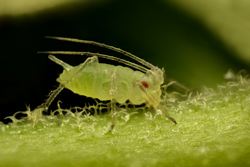Symbiotic relationships to control aphid pests
Aphids and other insects are major pests to the agriculture industry. Increasingly, the industry is using biological control agents (natural predators) to mitigate the impact of pests on crops. Another factor in addressing pest control is the symbiotic bacteria that help insects to harness and benefit from the plants they feed and live on. Symbiotic bacteria can contribute essential nutrients to the diets of insects, or help them to overcome the defence mechanisms of plants. An EU-funded project, PLANTINSECTSYMBIONT (The role of insect symbionts in host plant use through their effect on plant-induced defenses), investigated the effect of symbiotic bacteria on the pea aphid, the pea plant it lives on, and one of its predators, a parasitic wasp. The researchers found that when pea aphids with symbiotic bacteria attacked a pea plant, the plant released less defensive chemicals. These are the chemicals used by the aphid's predator – the parasitic wasp – to locate its insect host. Thus, aphids with symbiotic bacteria were protected from plant defences and better able to resist infection by the parasitic wasp than those without the bacteria. Another finding was that symbiotic bacteria on aphids are not always present, despite being able to protect aphids from predation. This is because when predators are not present, the symbiotic bacteria are energetically costly for aphids to keep. Symbiotic bacteria offer both a challenge and an opportunity for effective pest control. They could limit the effectiveness of biological control agents, such as parasitic wasps. But, they could also be a vehicle for delivering gene products to their hosts or their hosts' predators. The findings of this project will have environmental, agricultural, technological, economic and societal impacts. It provides new insights for future researchers who aim to tackle insect pests.







